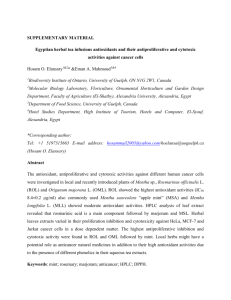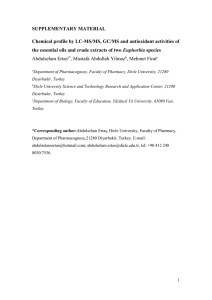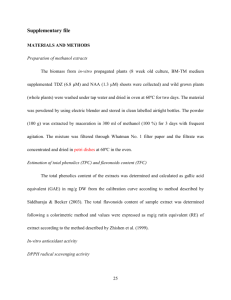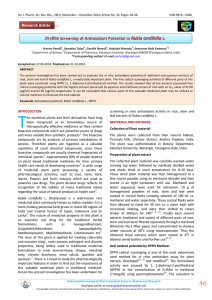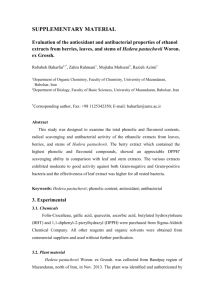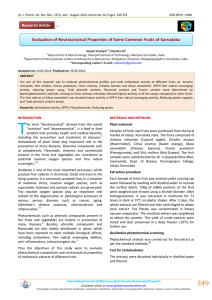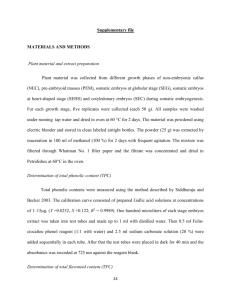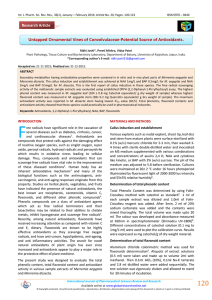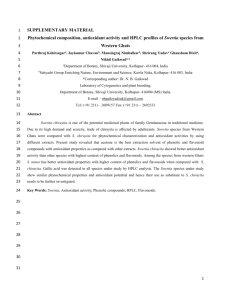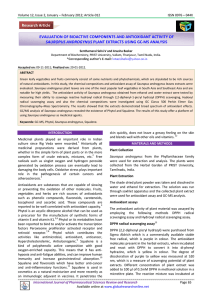SUPPLEMENTARY MATERIAL Antioxidant activities and phenolics
advertisement
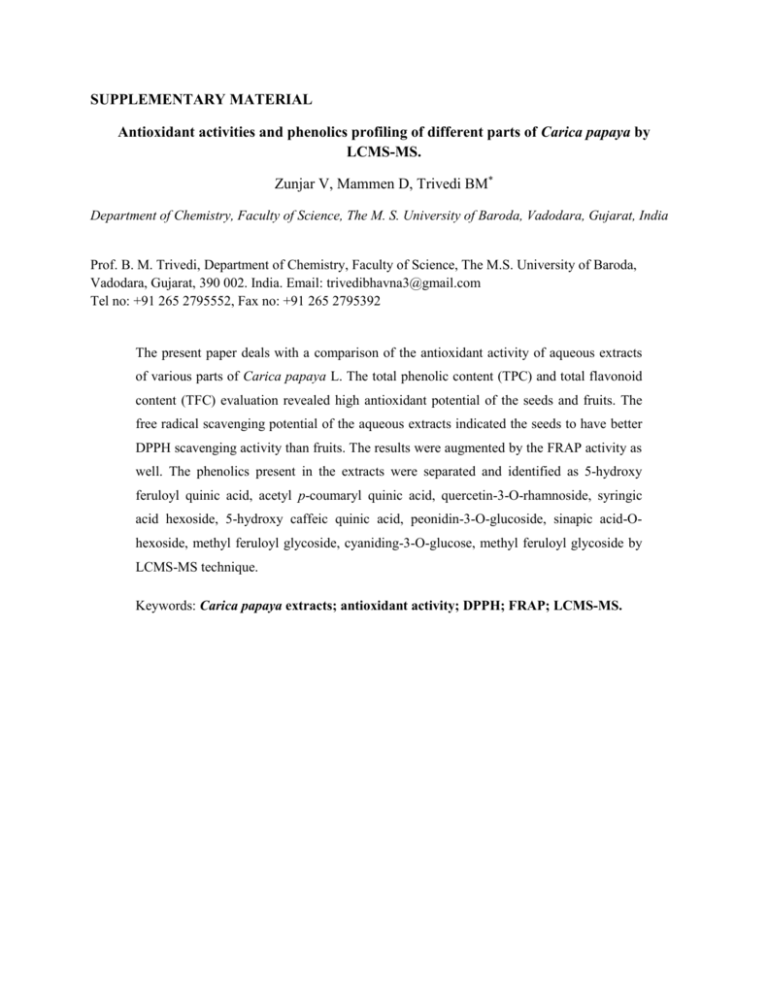
SUPPLEMENTARY MATERIAL Antioxidant activities and phenolics profiling of different parts of Carica papaya by LCMS-MS. Zunjar V, Mammen D, Trivedi BM* Department of Chemistry, Faculty of Science, The M. S. University of Baroda, Vadodara, Gujarat, India Prof. B. M. Trivedi, Department of Chemistry, Faculty of Science, The M.S. University of Baroda, Vadodara, Gujarat, 390 002. India. Email: trivedibhavna3@gmail.com Tel no: +91 265 2795552, Fax no: +91 265 2795392 The present paper deals with a comparison of the antioxidant activity of aqueous extracts of various parts of Carica papaya L. The total phenolic content (TPC) and total flavonoid content (TFC) evaluation revealed high antioxidant potential of the seeds and fruits. The free radical scavenging potential of the aqueous extracts indicated the seeds to have better DPPH scavenging activity than fruits. The results were augmented by the FRAP activity as well. The phenolics present in the extracts were separated and identified as 5-hydroxy feruloyl quinic acid, acetyl p-coumaryl quinic acid, quercetin-3-O-rhamnoside, syringic acid hexoside, 5-hydroxy caffeic quinic acid, peonidin-3-O-glucoside, sinapic acid-Ohexoside, methyl feruloyl glycoside, cyaniding-3-O-glucose, methyl feruloyl glycoside by LCMS-MS technique. Keywords: Carica papaya extracts; antioxidant activity; DPPH; FRAP; LCMS-MS. Experimental Chemicals Folin–Ciocalteu reagent, gallic acid, quercetin, DPPH, trichloroacetic acid were purchased from the Sigma Aldrich (India). All other chemicals used for the study were of analytical grade and obtained from Merck (India), and Sisco Research Laboratory (SRL), Mumbai, India. Conductivity water was used for all the analysis. HPLC grade methanol (99.9%) was purchased from Merck (India) and acetic acid (99.8%) from (Spectrochem, India). ferulic acid (trans-4hydroxy-3-methoxycinnamic acid, 99%), caffeic acid (3,4-dihydroxycinnamic acid, 97% predominantly trans), syringic acid (4-hydroxy-3,5-dimethoxybenzoic acid, 98%), gallic acid (3,4,5-trihydroxybenzoic acid, 97%), protocatechuic acid(3,4-dihydroxybenzoic acid, 98%), gentisic acid (2,5-dihydroxybenzoic acid, 98%), veratric acid (3,4-Dimethoxybenzoic acid, 99%), p-coumaric acid (trans-4-hydroxycinnamic acid, 98%), o-coumaric acid (trans-2hydroxycinnamic acid, 99%), m-coumaric acid (trans-3-hydroxycinnamic acid, 98%), sinapic acid (3,5-dimethoxy-4-hydroxycinnamic acid, 99%), p-hydroxybenzoic acid (4-hydroxybenzoic acid, 98%), vanillic acid (4-hydroxy-3- methoxybenzoic acid, 97%), chlorogenic acid [1,3,4,5tetrahydroxycyclohexanecarboxylic acid 3-(3,4-dihydroxycinnamate), 95%] were purchased from Sigma–Aldrich (India). HPLC water was obtained from Merck (India). Plant material The leaves, stems, seeds, fruits, and roots of Carica papaya L. collected in February 2011 from Vadodara, Gujarat, India. The whole plant was identified and authenticated by Prof. Dr. M Daniel at Department of Botany, The M. S. University of Baroda, Gujarat, India. The voucher specimen of this plant (No. BARO/2010/51) was deposited at the Herbarium, BARO, Department of Botany, The M. S. University of Baroda. The plant material was washed, shade dried for a day and then dried completely in an oven at 380C. The plant materials were coarsely powdered using a rotary grinder and stored in airtight plastic containers. Preparation of extracts The plant materials were subjected to soxhlet extraction in methanol. Solvent was evaporated under vacuum and the residue was treated with conductivity water in order to dissolve phenolic components and to remove the interference of chlorophyll and other non polar components. The aqueous extract was filtered, concentrated under high vacuum and reconstituted in HPLC grade methanol. Total phenolic contents (TPC) The Folin–Ciocalteu spectrophotometric method (Singleton, 1999; Nazaruk et al, 2008) was used to determine the content of the total phenolic compounds in each extract. Each plant extract (0.5 ml) was mixed with 5 ml of the Folin-Ciocalteu reagent (1:10 dilution with water) and 4 ml of Na2CO3 (75 gm/L) and the absorbance was measured with a double beam UV/Vis spectrophotometer (Perkin Erlmer, lamda 25) at 765 nm after 30 minute of incubation at room temperature. TPC were expressed as gallic acid equivalents. Total flavonoids determination Aluminium chloride colorimetric method was used for flavonoid determination (Ordonez, 2006; Chandrashekhar, 2009). Each plant extract (0.5 ml of 5 mg/ml) in methanol was separately mixed with 1.5 ml of methanol, 0.1 ml of 10% aluminium chloride, 0.1 ml of 1 M potassium acetate and 2.8 ml of distilled water. The solutions were incubated at room temperature for 30 minute; the absorbance of the reaction mixture was measured at 415 nm with a double beam UV/Vis spectrophotometer (Perkin Elmer, Lamda 25). The calibration curve was prepared by employing quercetin solutions of concentrations 12.5 to 100 g/ml in methanol. DPPH radical scavenging activity The DPPH radical scavenging activity of C. papaya parts extract was estimated according to the method of Brand-williams (1995) (Salah, 2006). After 0.5 ml of C. papaya parts extract had been mixed with 3.5 ml of 90 µM DPPH in methanol for 10 min, the absorbance of the sample was measured at 513.6 nm. The quenching of DPPH radical were monitored by a decrease in absorbance at 513.6 nm, which was recorded after 0, 1, 2, 3, 4 and 5 minutes and subsequently every 5 minutes up to 30 min, during which time the radical was stable. The percentage of remaining DPPH radical scavenging activity was expressed as percent inhibition IC 50 by plotting the DPPH% remaining in the steady state against various concentrations of each extract (5, 2.5, 1.25, 0.625, 0.312 mg/ml) and was calculated using the following formula: % DPPH radical scavenging activity = (1 - sample OD/control OD) × 100 Ferric-reducing antioxidant power (FRAP) This method determines the potential of antioxidants in different parts of C. papaya extract (1 ml) to reduce the ferricyanide complex to the ferrous form (Oyaizu, 1986; Merghache, 2014). One millilitre of extracts in different dilutions was added to 2.5 ml phosphate buffer (1 ml, 0.2 M, pH 6.6) and 2.5 ml potassium ferricyanide (1% w/v). The mixture was then incubated in a water bath at 500C for 20 min followed by 2.5 ml trichloroacetic acid (10% w/v) solution. The contents of the tubes were mixed well and 2.5 ml of solution was removed from each tube, to which 2.5 ml water and 0.5 ml ferric chloride solution (0.1% w/v) were added. The mixtures were allowed to stand for 30 min before absorbance measurements were taken at 700 nm. Triplicate solutions were prepared for each extract. The FRAP values, expressed in mg GAE/g, were derived from a standard curve. Extracts preparation for LCMS-MS The air-dried and finely powdered parts of C. papaya (280 g) were macerated overnight, in petroleum ether and cyclohexane mixture for defatting at room temperature. The residue was then extracted with methanol, which was further distilled and the residue was hydrolyzed with 7% CF3COOH (Rommel, 1993; Meda et al, 2011). Furthermore filtration of hydrolyzed fraction was done, and subjected to sequential extraction with ethyl acetate three times. Using 15% acetic acid as a mobile phase for paper chromatography which was used for elution of the concentrated ethyl acetate extracts and then phenolic bands were cut and eluted in HPLC grade methanol, filtered through Millipore filter and used for LCMS-MS studies. Ultra performance liquid chromatography/tandem mass spectrometry (UPLC/MS/MS) Liquid chromatographic separation was performed on an EXSIGENT UPLC system (AB SCIEX Framingham, USA) with ANALYST Software. Hypersil C-18 column 250 × 4.6 mm, 5 μm particle size (Leknokroma, Barcelona, Spain) was used for separation of phenolics. Prior to mass spectrometric (MS) analysis, a binary mobile phase consisting of 0.1% acetic acid (A) and 100% methanol (B) was used under the following gradient conditions: 0.01 min, 100% B; 10.0 min, 90% B; 20.0 min, 85% B; 30 min, 70% B; 50 min, 50% B; and at 55.5 min until the end of 60 min run, 100% B, for re-equilibration of the column before the next injection. The eluting stream from the UPLC was introduced into AB SCIEX 3200 Q TRAP atmospheric pressure ionization (API) mass spectrometer (ANALYST SOFTWARE, AB SCIEX Corp, Framingham, USA) equipped with an electrospray ionization (ESI) multi-mode ionization probe (ESI APCI). All spectra were obtained in negative mode ESI and the scan was set at m/z100-1200 Da. The LCESI source operation parameters were as the following: ion spray voltage, -2700V. Nitrogen was used as curtain and desolvation gas at the respective pressure of CUR: 20, GS1: 50, GS2: 50 (arbitrary unit). Block source temperature was maintained at 700uC, with the respective voltages: ISV: 4500 V, EP: -10 V, CXP: 35 V. (Balcke, 2012) 4. Statistical analysis Results were expressed as the mean ± the standard deviation of triplicate analysis. Statistical comparisons were performed using the Student’s t-test. Differences were considered significant at p < 0.05. The correlation coefficient (r2) between the parameters tested was established by regression analysis. References Brand-Williams W., Cuvelier M. E. & Berset C. (1995). Use of free radical method to evaluate antioxidant activity. Lebensm. Wiss. Technology, 28, 25–30. Balcke GU, Handrick V, Bergau N, et al. (2012). An UPLC-MS/MS method for highly sensitive high-throughput analysis of phytohormones in plant tissues. Plant Methods, 8, 47. Chandrashekhar H. R., Venkatesh P., Ponnusankar S. & Vijayan P. (2009). Antioxidant activity of Hypericum hookerianum Wight and Arn, Natural Product Research, 23(13), 12401251. Meda R.N.T., Vlase L., Lamien-Meda A., Lamien C.E., Muntean D., Tiperciuc B., Oniga I. & Nacoulma O.G. (2011). Identification and quantification of phenolic compounds from Balanites aegyptiaca (L) Del (Balanitaceae) galls and leaves by HPLC–MS, Natural Product Research, 25(2), 93-99. Merghache D., Boucherit-Otmani Z., Merghache S., Chikhi I., Selles C.& Boucherit K. (2014). Chemical composition, antibacterial, antifungal and antioxidant activities of Algerian Eryngium tricuspidatum L. essential oil, Natural Product Research, 28(11), 795-807. Nazaruk J., Czechowska S.K., Markiewicz R. & Borawska M.H. (2008). Polyphenolic compounds and in vitro antimicrobial and antioxidant activity of aqueous extracts from leaves of some Cirsium species, Natural Product Research, 22(18), 1583-1588. Ordonez A.A.L., Gomez J.D., Vattuone M.A. & Isla M.I. (2006). Antioxidant activities of Sechium edule (Jacq.) Swartz extracts, Food Chemistry, 97, 452-458. Oyaizu M. (1986). Studies on products of browning reaction: antioxidative activities of products of browning reaction prepared from glucosamine, Jpn. J. Nutr., 44, 307 - 315. Rommel A. & Wrolstad R.E. (1993). Influence of Acid and Base Hydrolysis on the Phenolic Composition of Red Raspberry Juice. J. Agric. Food Chem., 41, 1237-1241. Salah K.B.H., Mahjoub M.A., Ammar S., Michel L., Millet-Clerc J., Chaumont J.P., Mighri Z. & Aouni M. (2006). Antimicrobial and antioxidant activities of the methanolic extracts of three Salvia species from Tunisia, Natural Product Research, 20(12), 1110–1120. Singleton V.L., Orthofer R. & Lamuela-Raventos R.M. (1999). Analysis of total phenols and other oxidation substrates and antioxidants by means of Folin-Ciocalteau reagent, Methods Enzymol., 299, 152-178. Table S1: Retention times (min) and observed mass of phenolics in all parts of C. Papaya plant R.T. (min) MS[M-1]-1 (m/z) MS2 (m/z) Root Leaf Stem Fruit seed 18.128 417 373, 238 -- √ √ -- -- 32.506 373.1 358, 345.1 -- √ √ -- -- 37.093 384.2 370, 355.7, 340 -- -- -- -- √ 37.131 379.3 337 √ -- -- -- √ 38.032 353 309.5 √ √ √ √ √ 38.209 351.1 325.1 -- √ -- -- √ 38.231 356.9 330, 315.1 -- √ -- √ -- 38.46 446.9 223.1 √ -- -- -- √ 9 quercetin 3-O40.447 glycoside 463.1 445.3, 405, 362.3 -- -- -- √ √ 10 syringic acid hexoside 5-hydroxy caffeic quinic acid kaempherol-3O-rhamnoside peonidin 3-Oglucoside feruloyl-Ohexoside caffeoylhexose deoxyhexoside 40.811 359.5 315.1 -- √ √ -- √ 41.796 371 353.3, 343 -- -- √ -- √ 42.521 431 416.2, 235.1 √ √ -- -- √ 44.593 462.8 420 -- -- √ -- -- 45.018 355.3 337.8, 311.2 -- -- √ √ -- 45.529 486.7 443.2 -- -- -- √ -- Compounds 1 2 3 4 5 6 7 8 11 12 13 14 15 kaempferol-3O-pentoside syringiccaffeic acid ester 5-hydroxy feruloyl quinic acid acetyl pcoumaryl quinic acid chlorgenic acid p-coumaryl trimethyl glycoside 5-hydroxy caffeoyl-Oglycoside quercetin-3-Orhamnoside 16 17 18 19 20 sinapic acidO-hexoside methyl feruloyl glycoside p- coumaroyl quinic acid derivative feruloyl quinic acid cyanidin 3-Oglucose 46.424 385.3 370.3, 357.2 -- √ -- -- -- 46.868 383 368.3, 355 -- -- √ -- -- 48.817 351 336, 323 -- -- -- √ -- 48.836 367.2 323, 199.1 √ √ √ √ √ 52.301 449 388.9 -- -- √ -- √

